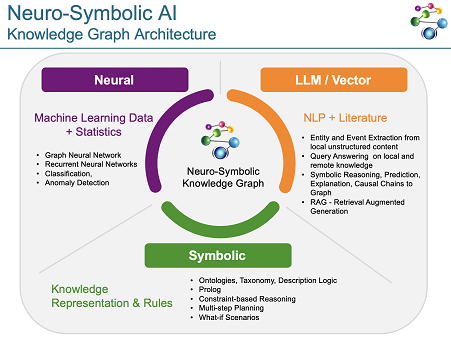Introduction to Neuro-Symbolic support in AllegroGraph
Neuro-Symbolic AI is a burgeoning field that marries two distinct realms of artificial intelligence: neural networks, which form the core of deep learning, and symbolic AI, which encompasses logic-based and knowledge-based systems. This synergy is designed to capitalize on the strengths of each approach to overcome their respective weaknesses, leading to AI systems that can both reason with human-like logic and adapt to new situations through learning.
Neuro-Symbolic AI aims to create models that can understand and manipulate symbols, which represent entities, relationships, and abstractions, much like the human mind. These models are adept at tasks that require deep understanding and reasoning, such as natural language processing, complex decision-making, and problem solving.
The following picture (borrowed from ScienceDirect) illustrates the Neuro-Symbolic AI setup.

The neural component of Neuro-Symbolic AI focuses on perception and intuition, using data-driven approaches to learn from vast amounts of unstructured data. Neural networks are exceptional at tasks like image and speech recognition, where they can identify patterns and nuances that are not explicitly coded. On the other hand, the symbolic component is concerned with structured knowledge, logic, and rules. It leverages databases of knowledge (Knowledge Graphs) and rule-based systems to perform reasoning and generate explanations for its decisions.
The interplay between these two components is where Neuro-Symbolic AI shines. It can, for example, use neural networks to interpret a complex image and then apply symbolic reasoning to answer questions about the image's content or to infer the relationships between objects within it.
Integrating Knowledge Graphs into Neuro-Symbolic AI is one of its most significant applications. Knowledge Graphs represent relationships in data, making them an ideal structure for symbolic reasoning. They can store facts about the world, which AI systems can then reason about. This is where platforms like AllegroGraph come into play.
AllegroGraph is a horizontally distributed Knowledge Graph Platform that supports multi-modal Graph (RDF), Vector, and Document (JSON, JSON-LD) storage. It is equipped with capabilities such as SPARQL, Geospatial, Temporal, Social Networking, Text Analytics, and Large Language Model (LLM) functionalities. These features enable scalable Knowledge Graphs, which are essential for building Neuro-Symbolic AI applications that require complex data analysis and integration.
In the context of Neuro-Symbolic AI, AllegroGraph's W3C standards based graph capabilities allow it to define relationships between entities in a way that can be logically reasoned about. The geospatial and temporal features enable the AI to understand and reason about the physical world and the passage of time, which are critical for real-world applications. The inclusion of LLMs allows for the processing and understanding of natural language, turning unstructured text into structured knowledge that can be added to the graph and reasoned about.
The combination of AllegroGraph's capabilities with Neuro-Symbolic AI has the potential to transform numerous industries. In healthcare, it can integrate and interpret vast datasets, from patient records to medical research, to support diagnosis and treatment decisions. In finance, it can analyze transactions within the context of evolving regulations to detect fraud and ensure compliance.

See also this this short film:
Other tools
In addition to Neuro-Symbolic AI support, AllegroGraph supports these tools:
- Large Language Models (LLM)
- Vector Stores
This unique combination of a Knowledge Graph (AllegrGraph itself), Vector Database, and deep LLM integration offers the industry's first Neuro-Symbolic AI Platform. By combining AllegroGraph 8.1.1's built in Symbolic AI Reasoning System with these new features, engineers can achieve unparalleled levels of AI-driven insights and decision-making. 'Neuro-Symbolic' describes the possibilities created by linking neural-network LLM technology with classical AI symbolic reasoning features including graph seach, RDFS++, and Prolog
This document points to the various documentation files describing these capabilities and also to the tutorials and examples showing their use. (Documentation files are also listed just below this file in the documentation index.)
The relevant documents are:
The last file contains numerous examples.